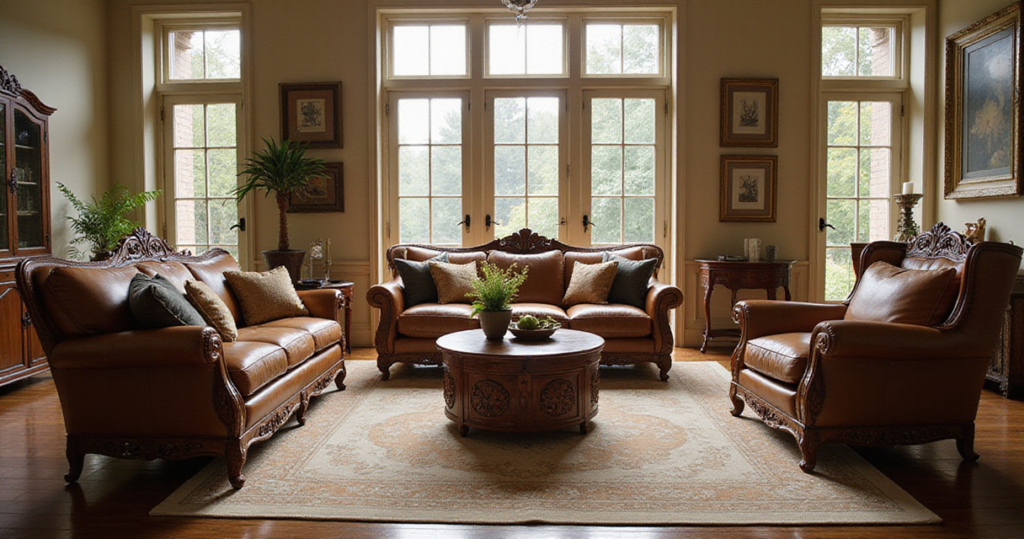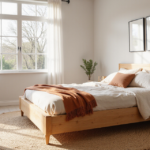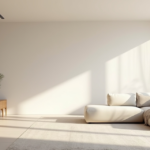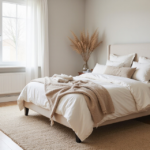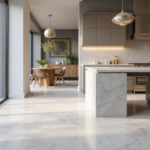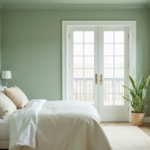Creating a luxury living room isn’t just about filling space with expensive pieces—it’s about orchestrating an experience that speaks to your soul every time you walk through the door. As someone who’s helped countless busy families transform their spaces without breaking the bank or their schedules, I’ve learned that true luxury comes from smart choices, not just big budgets.
The magic happens when you understand that luxury living room furniture should work as hard as you do. Every piece needs to earn its place through beauty, function, and the ability to adapt to your real life—whether that’s hosting impromptu playdates or elegant dinner parties. This isn’t about creating a museum; it’s about crafting a space that elevates your daily moments while standing up to the beautiful chaos of modern living.
Ready to discover how to curate a luxury living room that actually works for your lifestyle? These 18 essential tips will guide you through creating a space that’s both aspirational and livable, sophisticated yet family-friendly. Let’s dive into the art of making luxury accessible and practical.
1. Master the Art of Investment-Grade Quality Recognition
When you’re investing in luxury living room furniture, learning to spot true quality becomes your superpower. It’s not about the price tag—it’s about understanding what makes a piece worthy of your home and your hard-earned money. Look for solid wood construction with visible grain patterns, dovetail joints that lock together like puzzle pieces, and hardware that feels substantial in your hands.
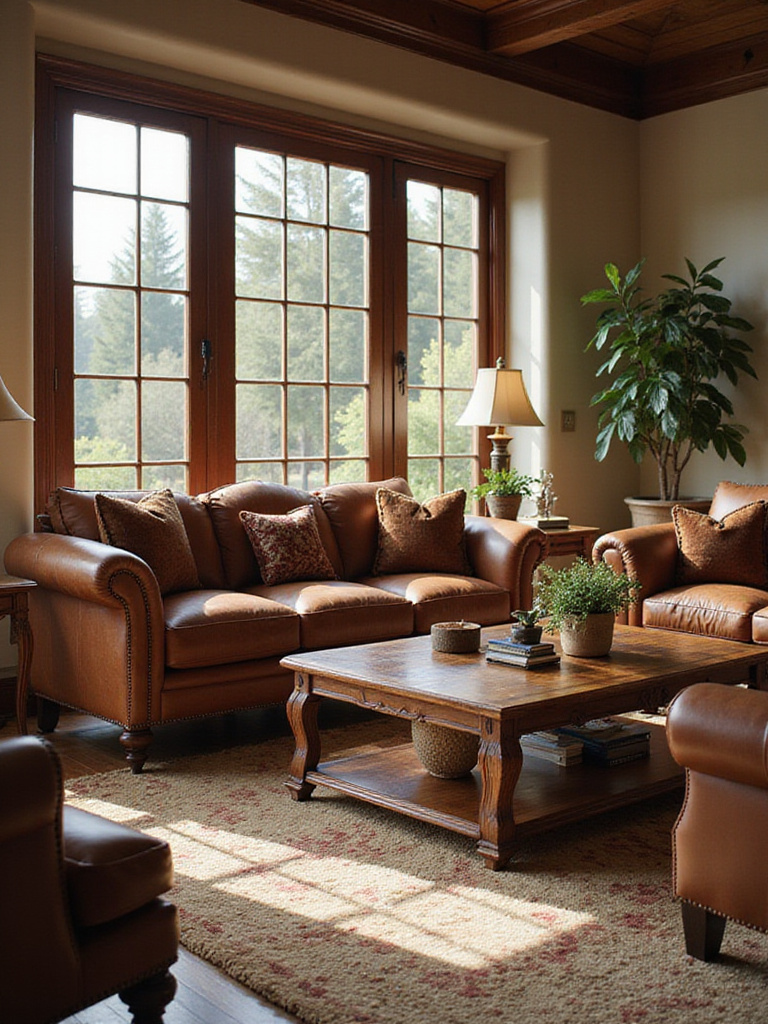
The difference between genuine luxury and expensive marketing becomes clear when you know what to examine. Run your fingers along edges—they should be smooth and precisely finished. Check drawer slides; they should glide effortlessly without wobbling. Quality upholstery reveals itself through tight, even stitching and fabric that feels substantial, not thin or scratchy. These details matter because they determine whether your furniture will age gracefully or show wear within the first year.
- Joint construction: Look for mortise-and-tenon, dovetail, or dowel joints instead of staples or visible glue
- Wood quality: Solid hardwoods like oak, walnut, or mahogany versus particle board or veneer
- Hardware assessment: Drawer pulls and hinges should operate smoothly with substantial weight
As we move beyond recognizing quality, the next step involves understanding how these premium pieces can actually save you money over time.
2. Calculate the True Cost of Furniture Over Time
Here’s something most people don’t consider: that “expensive” luxury sofa might actually cost less per year than replacing cheap furniture every few seasons. When you break down the math, quality pieces often deliver better value because they’re built to last decades, not just until your next move. I’ve seen families spend more on three mediocre sofas over ten years than they would have on one exceptional piece that could last thirty.
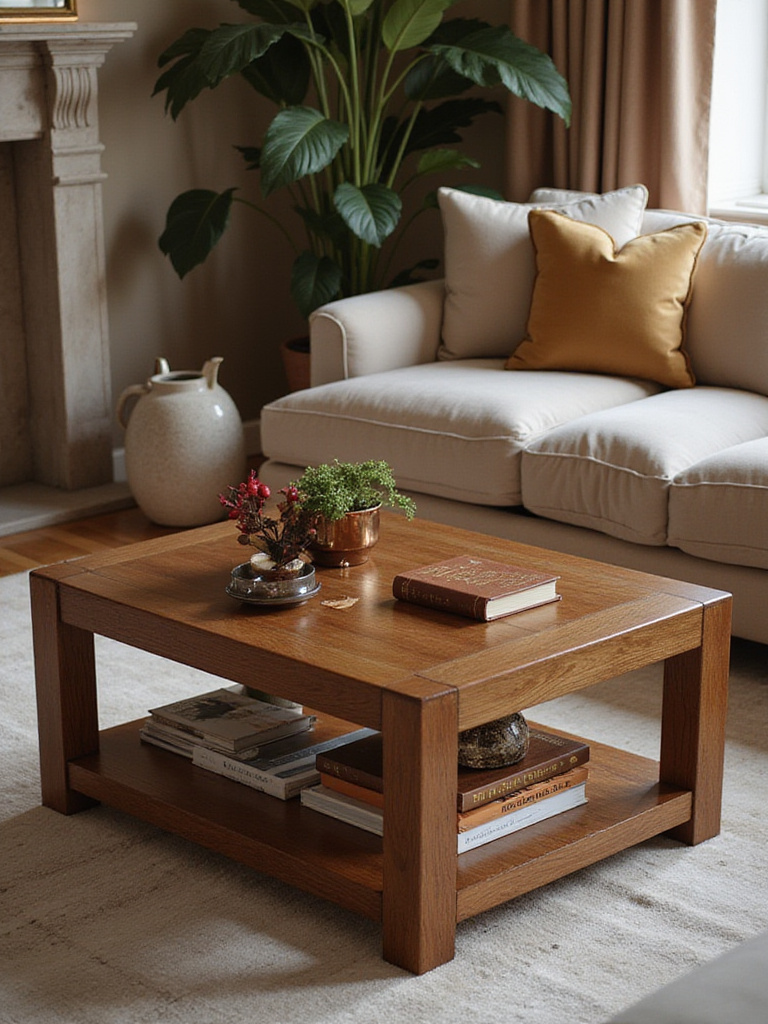
Think beyond the sticker price to the total cost of ownership. Quality luxury living room furniture requires less maintenance, holds its value better, and eliminates the stress and expense of frequent replacements. Factor in the hidden costs of cheap furniture: delivery fees for replacements, disposal costs, and the time spent shopping again and again. When a well-made dining table can serve three generations while a mass-market version might not survive one house move, the investment math becomes clear.
Quality pieces also adapt better to life changes. That modular sectional can reconfigure when you move to a different home. The solid wood coffee table can be refinished instead of replaced when tastes evolve. This flexibility means your initial investment continues paying dividends as your life changes.
The investment value becomes even clearer when you consider how these pieces can be viewed as assets rather than expenses.
3. Choose Your Sofa Like You’re Buying a Car
Your sofa is the engine of your living room—it needs to perform reliably for years while looking great and fitting your lifestyle perfectly. Just like car shopping, you need to test drive before buying. Sit on it for at least ten minutes, not just a quick perch. Lean back, stretch out, and imagine reading bedtime stories or hosting movie nights on this piece.
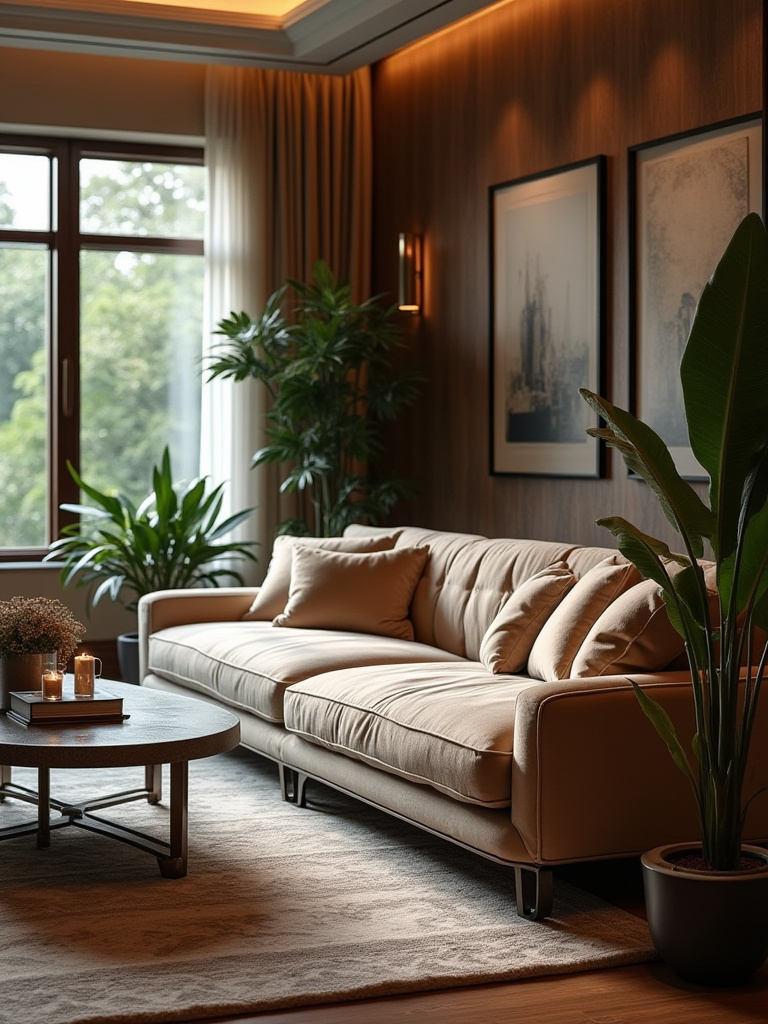
Frame construction matters more than fabric choice for longevity. Look for kiln-dried hardwood frames with eight-way hand-tied springs—this isn’t just fancy terminology, it’s the difference between a sofa that maintains its shape and one that develops permanent body impressions within months. The cushion fill determines daily comfort: high-density foam wrapped in down offers the best of both worlds—support that lasts with softness that welcomes.
Consider your real-life usage patterns when selecting luxury living room furniture. If you have kids or pets, performance fabrics aren’t compromising on luxury—they’re ensuring your investment stays beautiful. Crypton and similar technologies now offer fabrics that feel like silk but clean up like vinyl, perfect for families who refuse to choose between elegance and practicality.
With your anchor piece selected, the next consideration is how different upholstery materials will serve your specific lifestyle needs.
4. Decode Leather Quality Like a Pro
Not all leather is created equal, and understanding the grades can save you from expensive mistakes. Full-grain leather—the top layer of the hide—develops a beautiful patina over time and actually improves with age. Top-grain leather has been lightly sanded but still offers excellent durability. Avoid “genuine leather” (often the lowest grade) or bonded leather (leather scraps glued together) for luxury pieces.
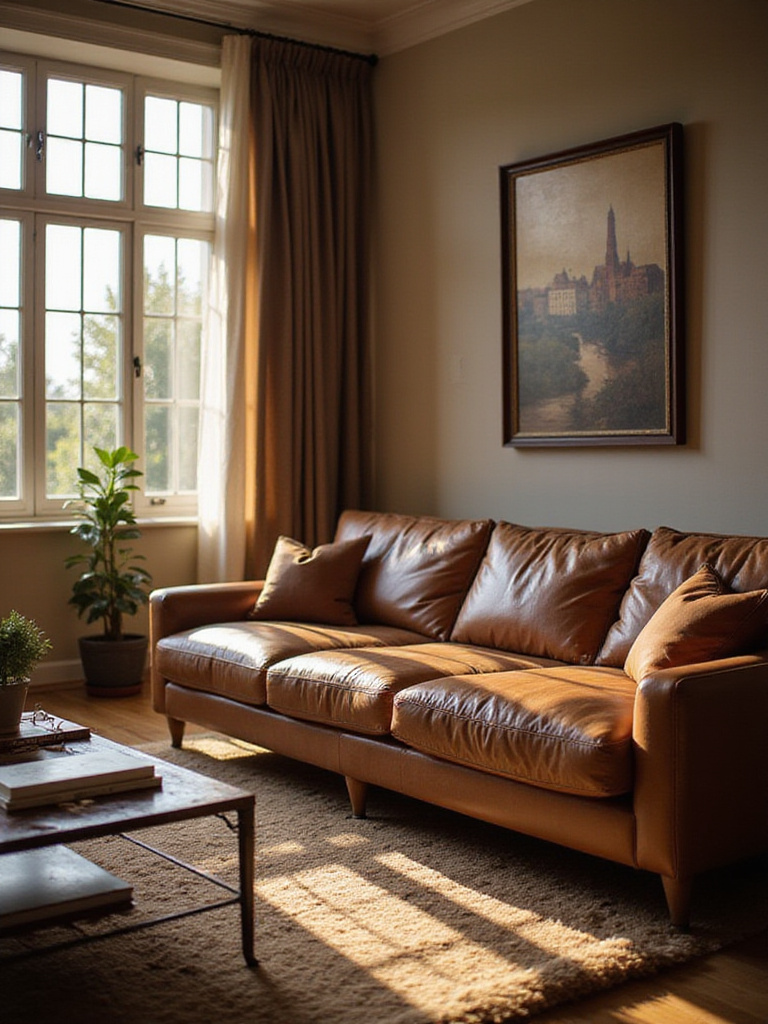
Feel the leather’s surface—quality hides show natural grain patterns and slight imperfections that prove authenticity. The leather should feel supple, not stiff or plasticky. Check the edges of cushions or under the furniture; genuine leather shows fibrous, natural-looking edges, while synthetic materials reveal their artificial backing. Quality leather also has a distinct, pleasant smell—avoid pieces with chemical or fishy odors.
- Full-grain leather: Premium choice that ages beautifully and lasts 20+ years
- Top-grain leather: Slightly processed but still excellent for high-use pieces
- Corrected-grain leather: Heavily processed, avoid for luxury applications
Consider your climate and usage when choosing leather. In humid areas, leather breathes better than fabric. For families with young children, darker colors and distressed finishes hide wear better than pristine, light-colored hides.
Beyond leather, the world of high-performance fabrics offers exciting possibilities for luxury pieces that truly work with modern lifestyles.
5. Navigate High-Performance Fabrics Without Sacrificing Style
Modern performance fabrics have revolutionized luxury living room furniture by eliminating the old trade-off between beauty and practicality. Today’s solution-dyed acrylics and advanced synthetic blends offer the look and feel of natural fibers while providing stain resistance, fade protection, and easy maintenance. Sunbrella’s indoor collections, for example, include velvets and linens that feel luxurious but clean with soap and water.
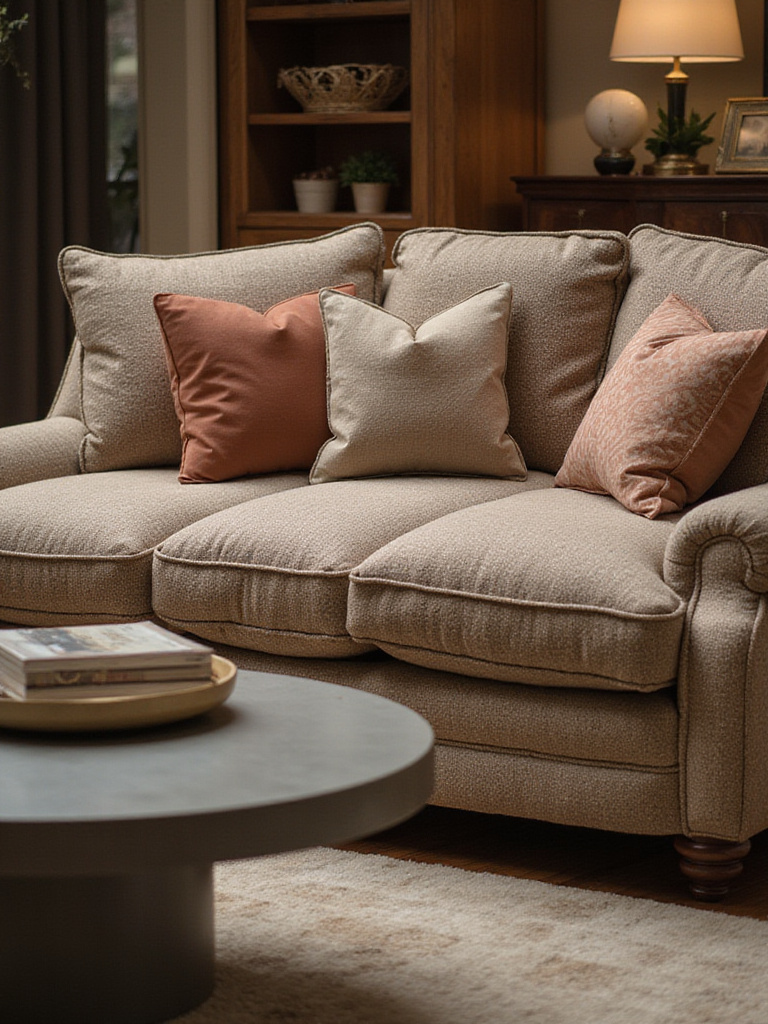
The key is understanding fabric specifications beyond just appearance. Look for high double-rub counts (25,000+ for heavy residential use), solution-dyed fibers that won’t fade, and treatments that resist stains without feeling coated or artificial. Many luxury furniture manufacturers now offer performance options in their premium lines, recognizing that today’s consumers want both elegance and livability.
Test fabric samples in your actual lighting conditions—colors and textures can appear dramatically different under your home’s specific natural and artificial light. Request large swatches and live with them for a week, observing how they look throughout the day and how they feel to touch repeatedly.
Performance doesn’t mean compromising on luxury—it means enhancing it by ensuring your beautiful pieces stay beautiful despite real life’s inevitable spills and wear.
Moving beyond the main seating, accent chairs offer opportunities to inject personality and create visual interest in your space.
6. Select Accent Chairs That Earn Their Space
Every piece of furniture in a luxury living room should justify its footprint, and accent chairs are no exception. The best accent chairs serve multiple purposes: additional seating when needed, visual interest as sculptural elements, and functional spots for reading or conversation. Choose chairs that complement your sofa without matching exactly—this creates sophisticated visual tension rather than a showroom look.
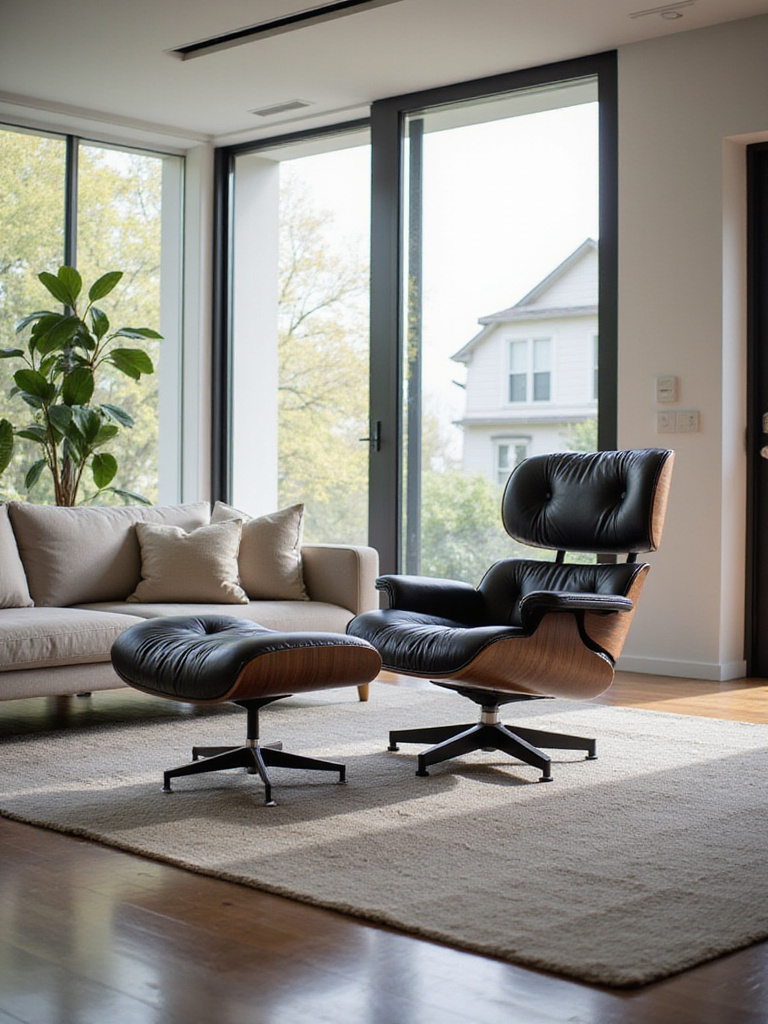
Consider the chair’s actual usability alongside its aesthetic appeal. A beautiful chair that’s uncomfortable won’t get used, making it expensive decoration rather than functional luxury living room furniture. Test the seat height, back support, and arm placement to ensure it works for your family’s needs. Swivel chairs offer flexibility in conversation groupings, while stationary pieces can anchor specific areas.
Scale matters enormously with accent chairs. In smaller rooms, choose chairs with exposed legs and lighter visual weight to maintain openness. In larger spaces, substantial chairs with bold upholstery can create intimate conversation areas within the broader room. The goal is creating layers of seating options that encourage use and conversation.
- Comfort testing: Sit for 10+ minutes to assess true comfort levels
- Scale consideration: Match chair size to room proportions and traffic flow
- Multi-functionality: Choose pieces that serve multiple purposes when possible
The strategic placement of these accent pieces leads naturally to considering your coffee table as the centerpiece that ties everything together.
7. Make Your Coffee Table the Room’s Hardest Worker
Your coffee table isn’t just a surface—it’s the command center of your living room. It needs to handle everything from morning coffee and evening wine to homework sessions and game nights, all while looking effortlessly elegant. Choose a table that’s proportional to your seating (about two-thirds the length of your sofa) and at the right height (within two inches of your seat cushions) for comfortable use.
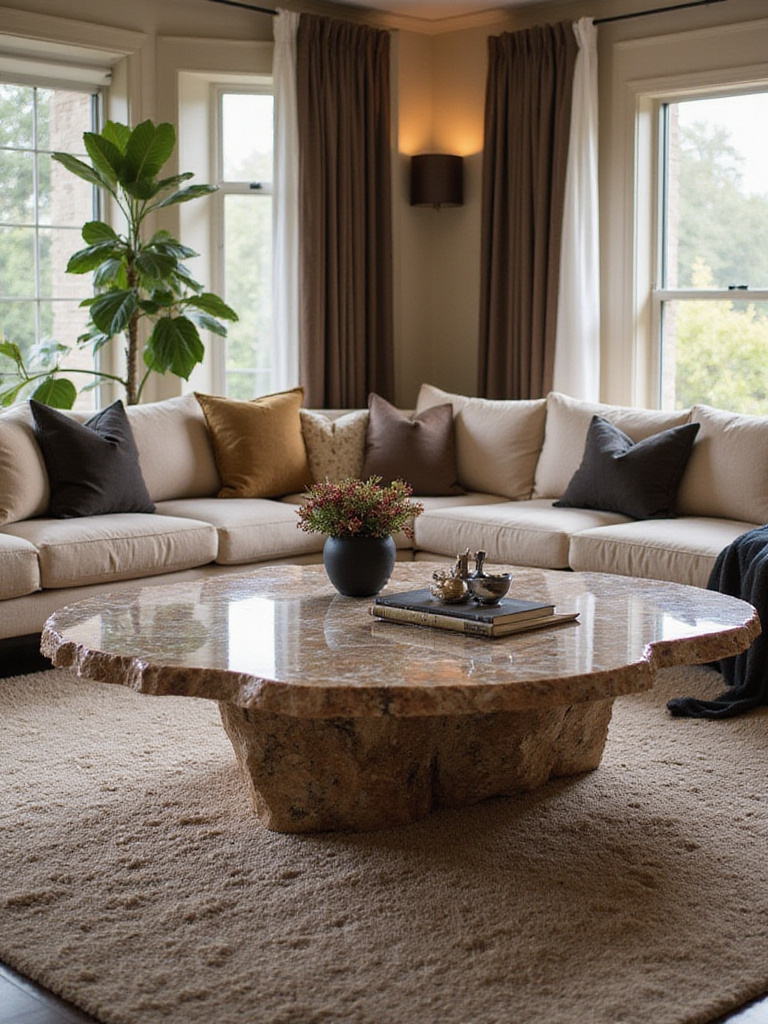
Material choice affects both aesthetics and functionality. Stone tops like marble or granite offer luxury appeal but require coasters and careful maintenance. Wood provides warmth and can handle more abuse, especially with proper finishing. Glass creates visual lightness but shows every fingerprint. Metal bases add industrial chic but can be cold to the touch. Consider your real usage patterns when making this choice.
Storage integration transforms a coffee table from pretty to practical. Ottoman-style tables with hidden storage, drawers for remotes and chargers, or lower shelves for books and games maximize functionality without sacrificing style. This hidden organization helps maintain the clean lines essential to luxury aesthetics while accommodating the realities of daily life.
The coffee table you choose will influence how you select and arrange the supporting cast of side tables and consoles throughout the room.
8. Layer in Functional Side Tables Strategically
Side tables are the unsung heroes of luxury living room furniture, providing essential surfaces exactly where you need them while adding visual interest through varied heights and materials. Place them within easy reach of seating—about 24 inches from chair arms—so drinks, books, and devices have convenient landing spots. This practical placement prevents the dreaded coffee table reach that interrupts conversation and relaxation.
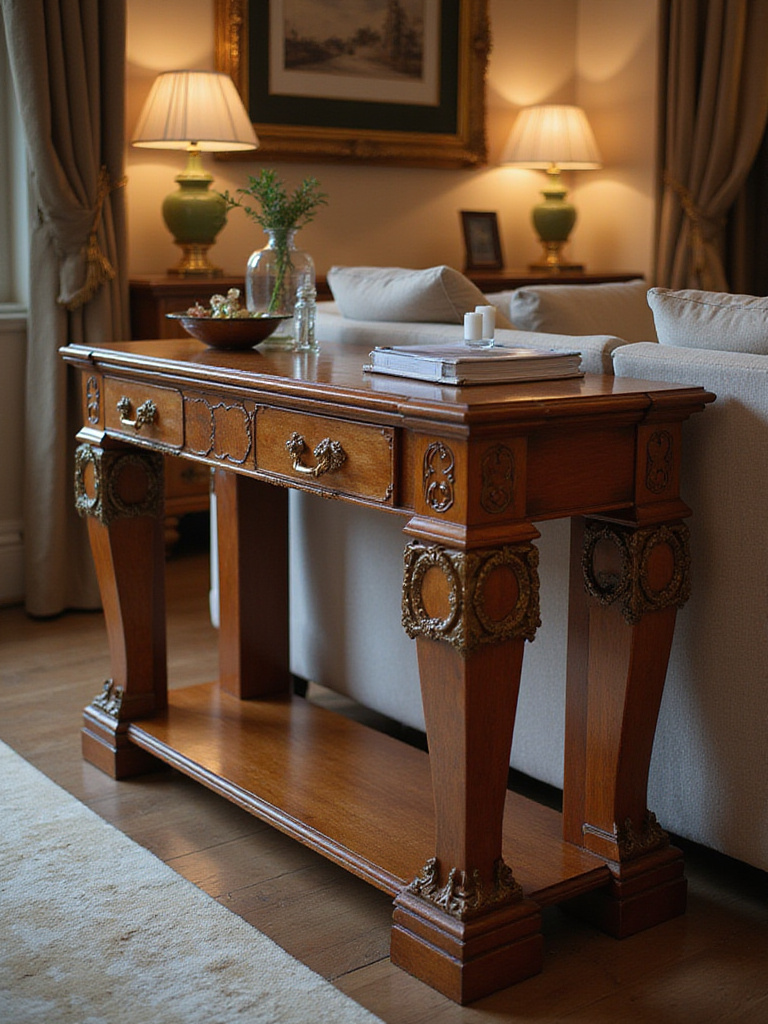
Mix heights and materials for visual dynamism while maintaining functional sense. A tall, narrow table beside a low, wide sofa creates pleasing contrast while serving different purposes—perhaps a reading lamp on the tall table and a decorative bowl on the low one. Nesting tables offer flexibility for entertaining, spreading out when you need extra surfaces and tucking away when you want open floor space.
Consider mobility for maximum versatility. Tables on discrete casters can move to where the action is—beside the sofa for movie night, near the window for afternoon reading, or flanking the fireplace for intimate conversations. This adaptability means your furniture works with your lifestyle rather than constraining it.
- Placement guidelines: Within 24 inches of seating for easy access
- Height variety: Mix tall and low pieces for visual interest and different functions
- Mobility options: Consider pieces that can relocate as needs change
With surface needs covered, the next priority is ensuring everything has a place through intelligent storage solutions.
9. Hide Clutter Without Hiding Style
Luxury living rooms maintain their serene elegance through strategic storage that keeps everyday necessities accessible but invisible. The best storage solutions integrate seamlessly with your design aesthetic—ottomans with hidden compartments, console tables with drawers, and built-in cabinetry that looks like millwork rather than furniture. This approach maintains clean lines while accommodating real life’s inevitable accumulation of stuff.
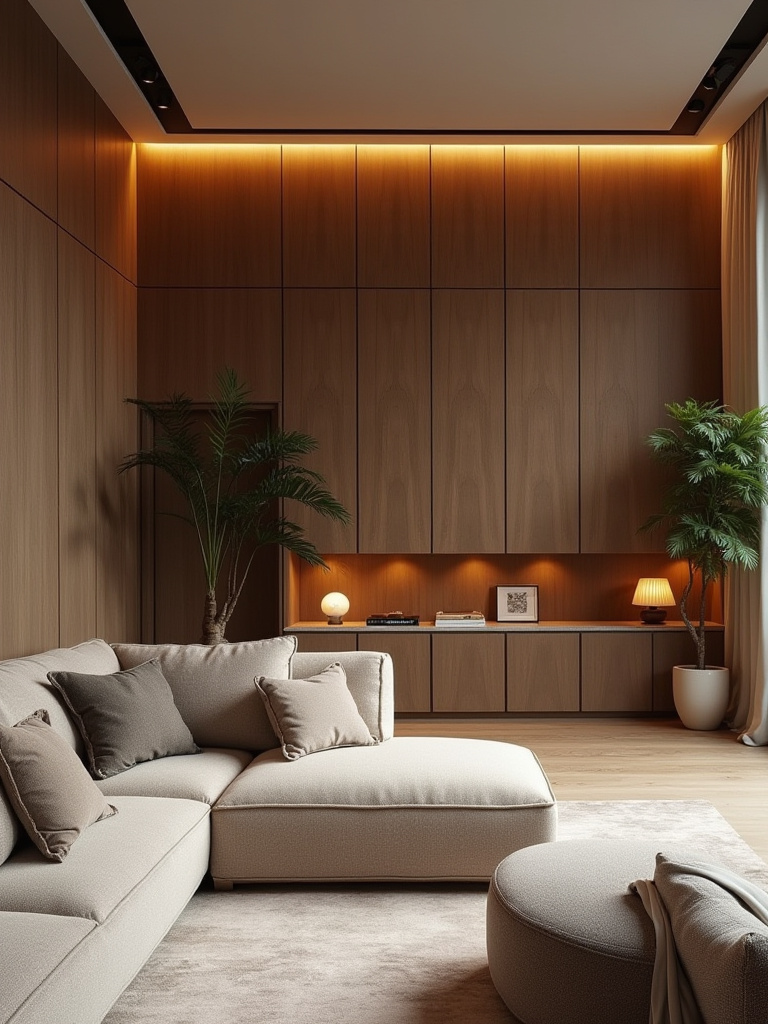
Technology integration requires special attention in modern luxury living room furniture. Charging stations, cable management, and media storage need sophisticated solutions that don’t compromise aesthetics. Look for consoles with cord management systems, tables with built-in charging pads, and seating with discrete USB ports. These features keep devices powered and organized without creating visual chaos.
Consider seasonal storage needs when planning your luxury living room. Throw blankets for chilly evenings, extra pillows for guests, and games for family time all need homes that don’t disrupt your carefully curated aesthetic. Bench seating with lift-tops, armoires that close to hide entertainment systems, and decorative baskets that corral remotes and chargers all serve this dual purpose.
The goal is creating a space that feels effortlessly organized, where everything has a designated place that doesn’t compromise the room’s sophisticated appearance.
With storage addressed, the next step involves ensuring all your beautiful pieces work together through proper scaling and proportional relationships.
10. Master Proportions for Professional Results
Getting proportions right is what separates amateur decorating from professional-looking luxury living room furniture arrangements. The classic rule of thumb—coffee tables should be about two-thirds the length of your sofa—exists because it creates visual harmony that feels naturally comfortable. But proportions extend beyond individual pieces to how everything relates within the space.
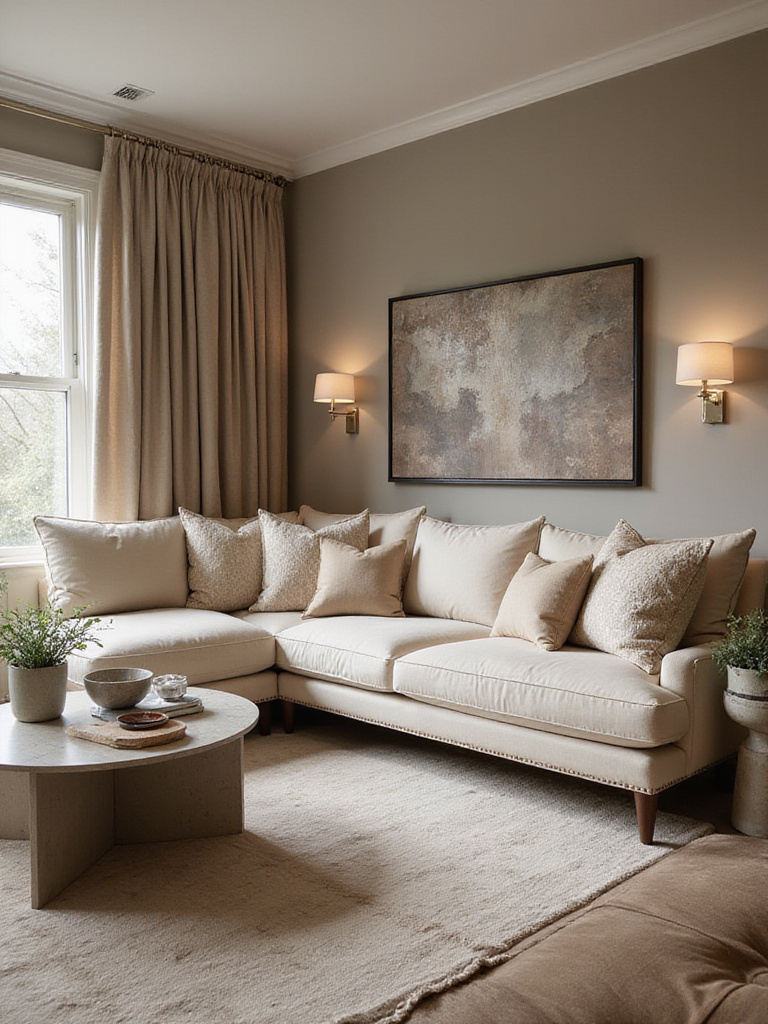
Ceiling height dramatically affects furniture scale requirements. Standard 8-foot ceilings call for lower-profile pieces that don’t overwhelm the space, while 10+ foot ceilings can handle—and actually require—taller, more substantial furniture to avoid looking lost. Vertical elements like tall bookcases, floor lamps, or large artwork help fill vertical space and create proper visual weight distribution.
Create visual anchors through strategic placement of your largest pieces first, then layer in smaller elements that support rather than compete. Your sofa typically serves as the primary anchor, with accent chairs and tables creating secondary focal points that guide the eye around the room in a pleasing flow.
- Sofa-to-coffee-table ratio: Table should be 2/3 the sofa’s length
- Ceiling height consideration: Taller ceilings require more substantial furniture
- Visual weight distribution: Balance large pieces with appropriate supporting elements
Proper proportions create the foundation for optimal traffic flow, which is our next critical consideration.
11. Design Traffic Patterns That Actually Work
Even the most beautiful luxury living room furniture arrangement fails if people can’t move comfortably through the space. Plan for 30-36 inches of walking space around major pieces, with 18 inches minimum between a coffee table and seating. These measurements aren’t arbitrary—they reflect how people naturally move and interact in living spaces.
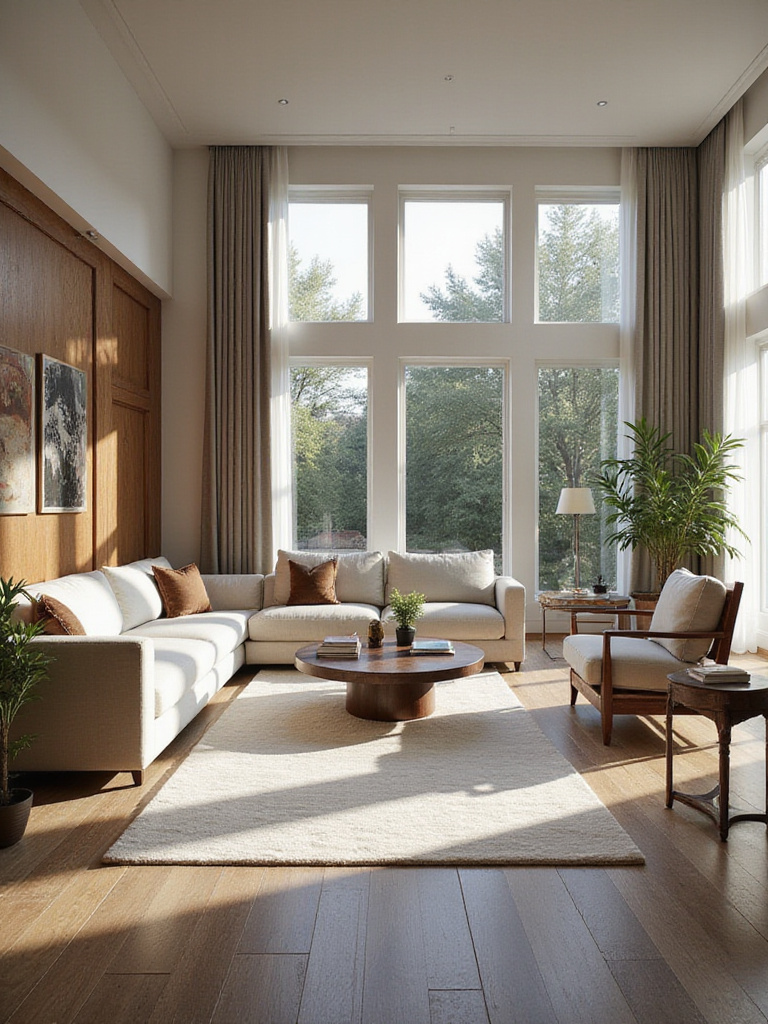
Consider how your family actually uses the room when planning layouts. If kids regularly race through to the backyard, ensure a clear path that doesn’t require navigating around delicate pieces. If you frequently entertain, create multiple conversation areas that don’t block each other or force guests to interrupt ongoing conversations to move around the room.
Floating furniture away from walls often improves flow better than pushing everything to the perimeter. A sofa pulled into the room with a console table behind it creates a natural pathway while defining the seating area. This approach works especially well in open-plan homes where the living room needs to flow seamlessly into adjacent spaces.
Test your planned layout by walking through it multiple times, carrying items like coffee cups or laundry baskets to simulate real-life movement. If you find yourself constantly bumping into furniture or taking awkward detours, adjust the arrangement before committing to the final placement.
Once flow is optimized, lighting becomes the element that transforms your space from merely functional to truly atmospheric.
12. Layer Lighting Like a Professional Designer
Lighting can make even modest furniture look luxurious, while poor lighting can diminish the most expensive pieces. Layer three types of lighting for optimal results: ambient (general room lighting), task (reading or work lighting), and accent (highlighting specific features or creating mood). This layered approach ensures your luxury living room furniture looks its best at any time of day.
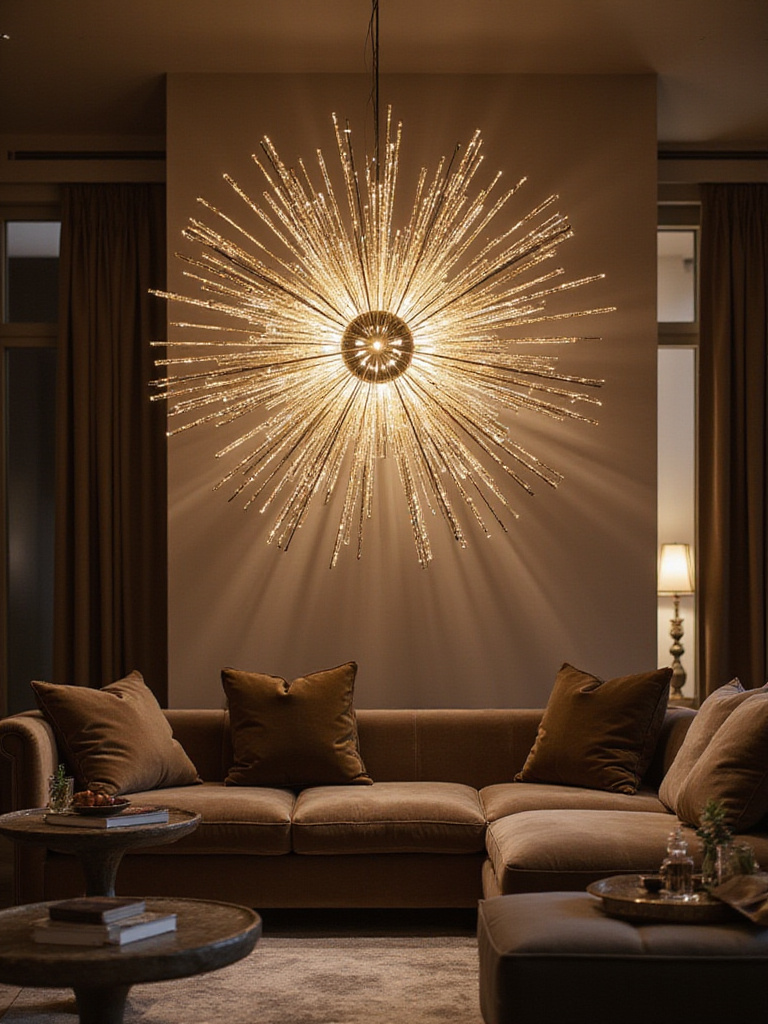
Dimmer controls are non-negotiable for luxury spaces. They allow you to adjust lighting intensity for different activities and times of day—bright for cleaning and games, dim for relaxation and conversation. Install dimmers on overhead fixtures, table lamps, and even accent lighting to create maximum flexibility.
Consider how light interacts with your furniture materials throughout the day. Natural light can fade fabrics and leather over time, so position vulnerable pieces away from direct sunlight or install UV-filtering window treatments. Conversely, use natural light to highlight beautiful wood grains or interesting textures during daytime hours.
- Three lighting layers: Ambient, task, and accent lighting for complete coverage
- Dimmer installation: Essential for mood control and flexibility
- Material protection: Shield sensitive materials from damaging UV exposure
Strategic lighting sets the stage for showcasing the rich material combinations that define luxury interiors.
13. Mix Materials for Visual Richness
The most compelling luxury living room furniture arrangements combine multiple materials to create visual and tactile interest. Pair smooth leather with rough-hewn wood, sleek metal with soft fabrics, or cool stone with warm textiles. This material mixing prevents the flat, monotonous look that comes from too much similarity while adding sophistication through thoughtful contrast.
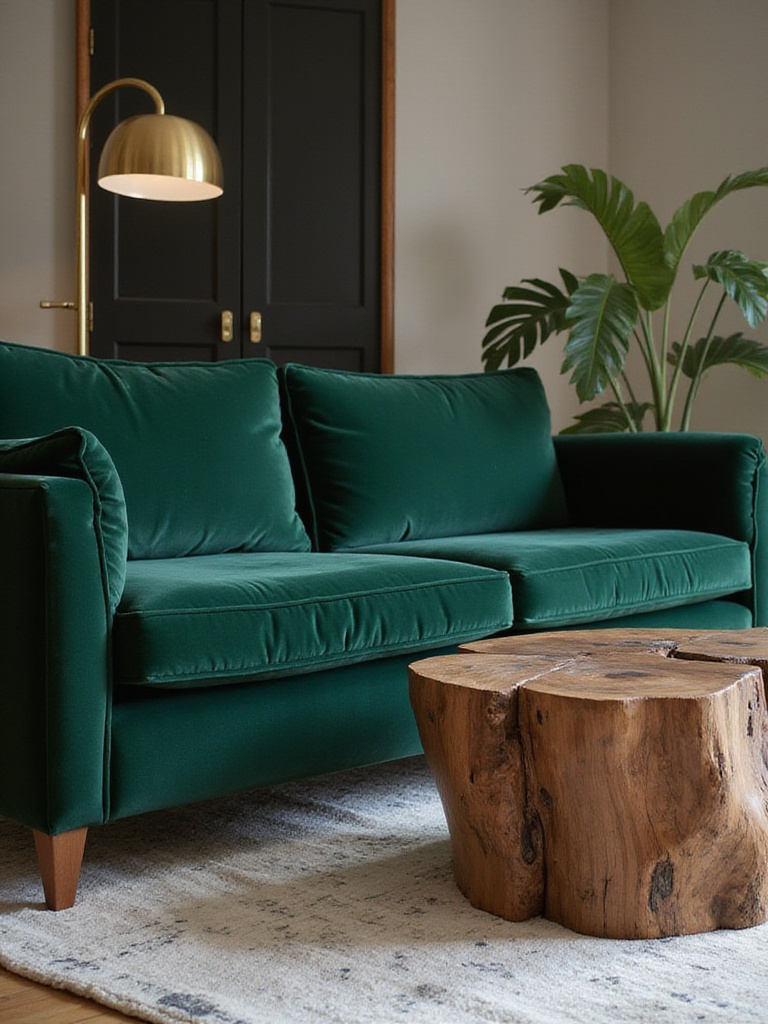
Limit your material palette to 3-4 primary types to avoid visual chaos. Within those categories, vary the finishes—matte and glossy metals, different wood stains, or various fabric textures. This approach creates richness without overwhelming the space or making it feel busy and unfocused.
Consider how materials age and patina over time when making selections. Some combinations improve with age—leather that softens and darkens, wood that develops character marks, metals that develop patina—while others may show wear less gracefully. Choose materials that will age beautifully together, enhancing rather than detracting from your investment over time.
Temperature contrast adds another layer of sophistication. Cool materials like stone, glass, and metal balanced with warm materials like wood, leather, and natural fibers create spaces that feel both elegant and inviting rather than cold or overly precious.
Material selection leads naturally to considering the sources and stories behind your furniture pieces.
14. Source from Makers Who Share Your Values
Today’s luxury consumers increasingly care about the story behind their purchases, seeking luxury living room furniture from makers who prioritize craftsmanship, sustainability, and ethical practices. Research brands’ manufacturing processes, material sourcing, and labor practices. Companies that are transparent about these practices typically have nothing to hide and take pride in their methods.
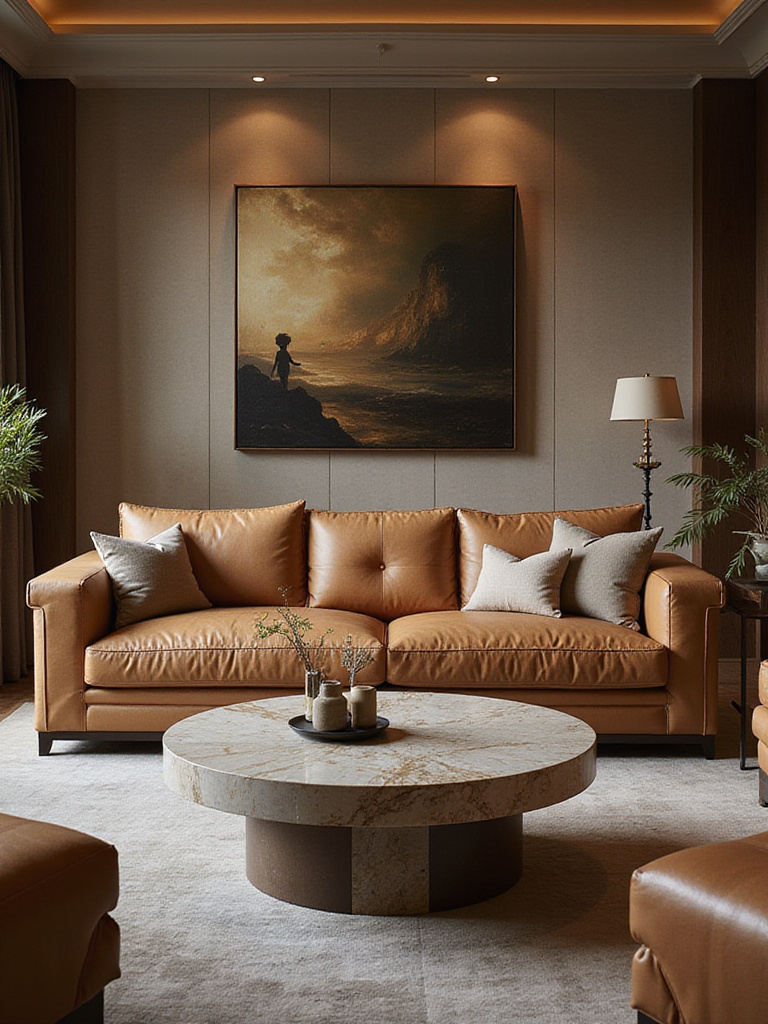
Look for certifications that matter: FSC (Forest Stewardship Council) for responsibly sourced wood, GREENGUARD for low chemical emissions, and fair trade certifications for textiles. These third-party verifications provide assurance that your beautiful furniture doesn’t come at the expense of environmental or social responsibility.
Consider the longevity factor when evaluating makers. Companies that offer repair services, replacement parts, and refinishing options demonstrate confidence in their products and commitment to sustainability. This support extends your furniture’s life and protects your investment while reducing environmental impact.
- Transparency indicators: Clear information about materials, processes, and labor practices
- Relevant certifications: FSC, GREENGUARD, fair trade, and similar third-party verifications
- Longevity support: Repair services, parts availability, and refinishing options
Understanding maker values helps inform decisions about when to invest in custom pieces versus selecting from existing collections.
15. Know When Custom Makes Sense
Custom luxury living room furniture makes sense when your space has unusual dimensions, specific functional requirements, or when you want something truly unique that reflects your personal style. However, custom pieces require more time, money, and involvement than selecting from existing collections. Evaluate whether the benefits justify the additional investment and complexity.
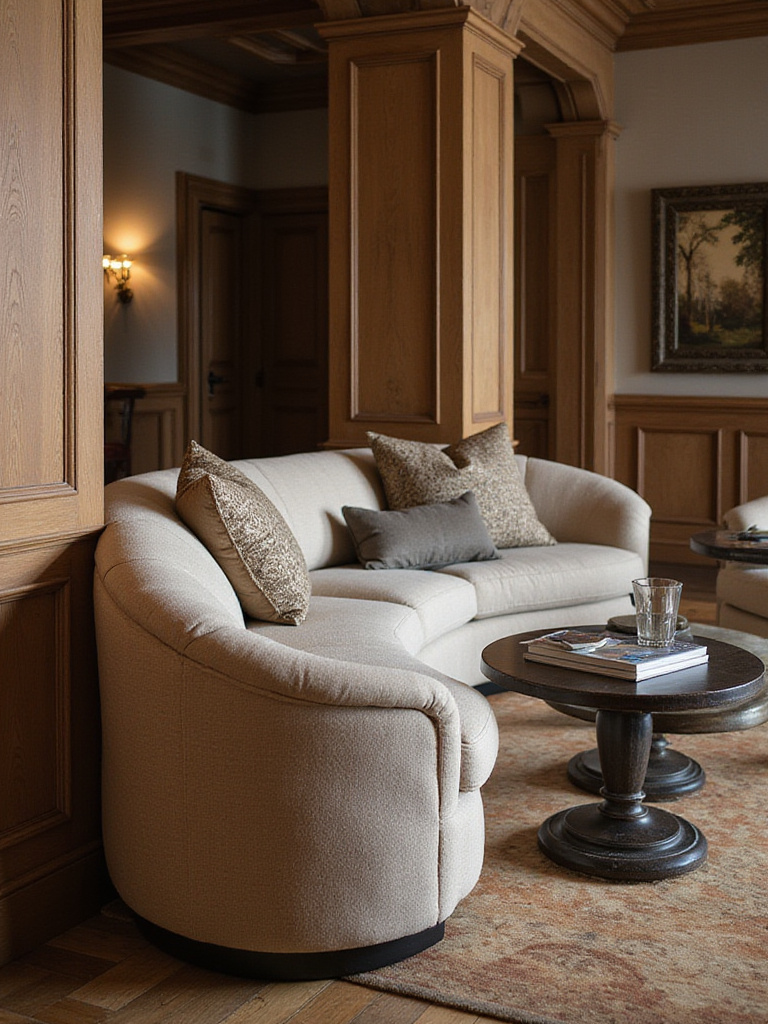
Timing is crucial for custom pieces. Plan for 12-16 weeks minimum for quality custom furniture, longer during busy seasons or for complex pieces. This timeline affects renovation schedules and room completion dates, so factor it into your overall planning. Rush orders typically cost more and may compromise quality, defeating the purpose of going custom.
Work with makers who show you detailed drawings, provide material samples, and offer clear timelines and pricing. Avoid anyone who can’t provide references, seems vague about processes, or requires large upfront payments. Quality custom makers typically request 50% down with the balance due on completion, and they’re happy to discuss their process in detail.
Document everything in writing, including materials, dimensions, finishes, timelines, and pricing. This protects both parties and ensures the final product matches your expectations. Changes mid-process often incur additional costs and delays, so finalize decisions before production begins.
Whether custom or ready-made, all luxury furniture requires proper care to maintain its beauty and value over time.
16. Protect Your Investment Through Proper Care
Luxury living room furniture represents a significant investment that proper care can protect for decades. Establish routine maintenance schedules based on material types—leather needs conditioning every 6-12 months, wood requires periodic polishing, and fabrics benefit from professional cleaning annually. These small investments in maintenance prevent major problems and preserve both appearance and value.
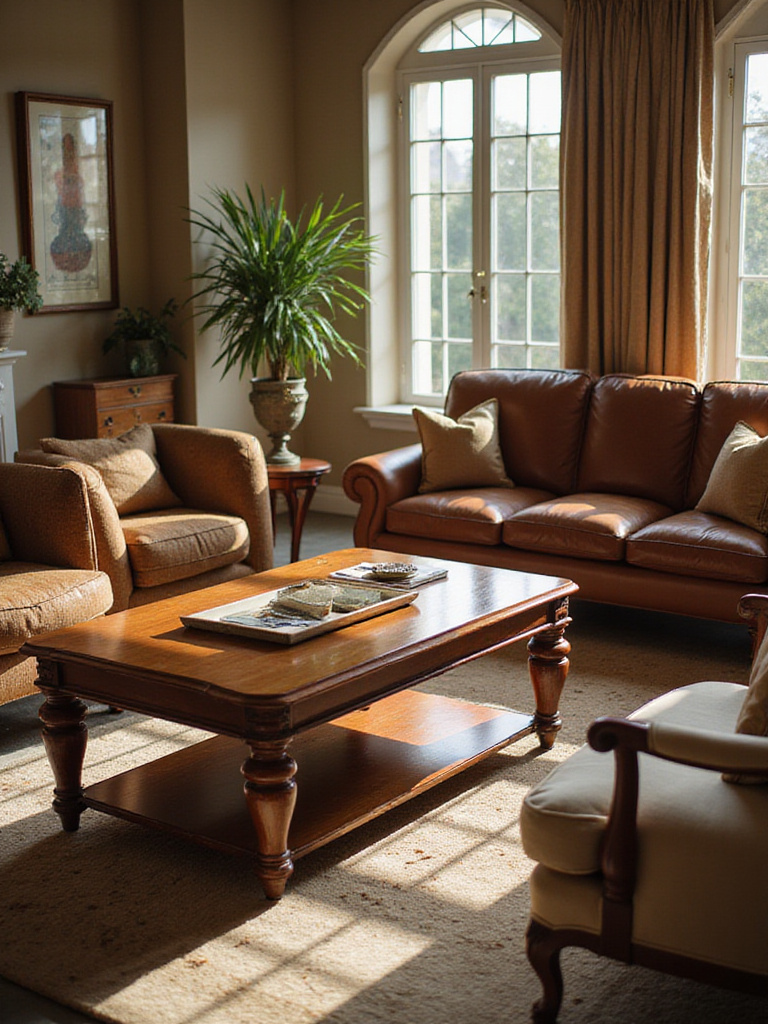
Climate control matters more for luxury furniture than many people realize. Extreme temperature swings and humidity changes can crack leather, split wood, and fade fabrics. Maintain consistent indoor conditions when possible, and consider humidifiers or dehumidifiers in extreme climates. Position furniture away from heat sources, air conditioning vents, and direct sunlight to minimize environmental stress.
Keep care instructions and warranty information organized and accessible. Many manufacturers provide specific care guidelines and approved cleaning products for their pieces. Following these recommendations maintains warranty coverage and ensures you’re not inadvertently damaging expensive materials with inappropriate cleaning methods.
- Routine schedules: Regular maintenance based on specific material requirements
- Climate considerations: Consistent temperature and humidity levels protect materials
- Documentation: Keep care instructions and warranty information accessible
Proper care preserves your investment while supporting the growing movement toward sustainable luxury consumption.
17. Embrace Sustainable Luxury Practices
Sustainable luxury isn’t an oxymoron—it’s the future of responsible consumption. Choose luxury living room furniture made from renewable materials, produced with minimal environmental impact, and designed to last for generations rather than seasons. This approach aligns luxury with values while often delivering superior quality and craftsmanship.
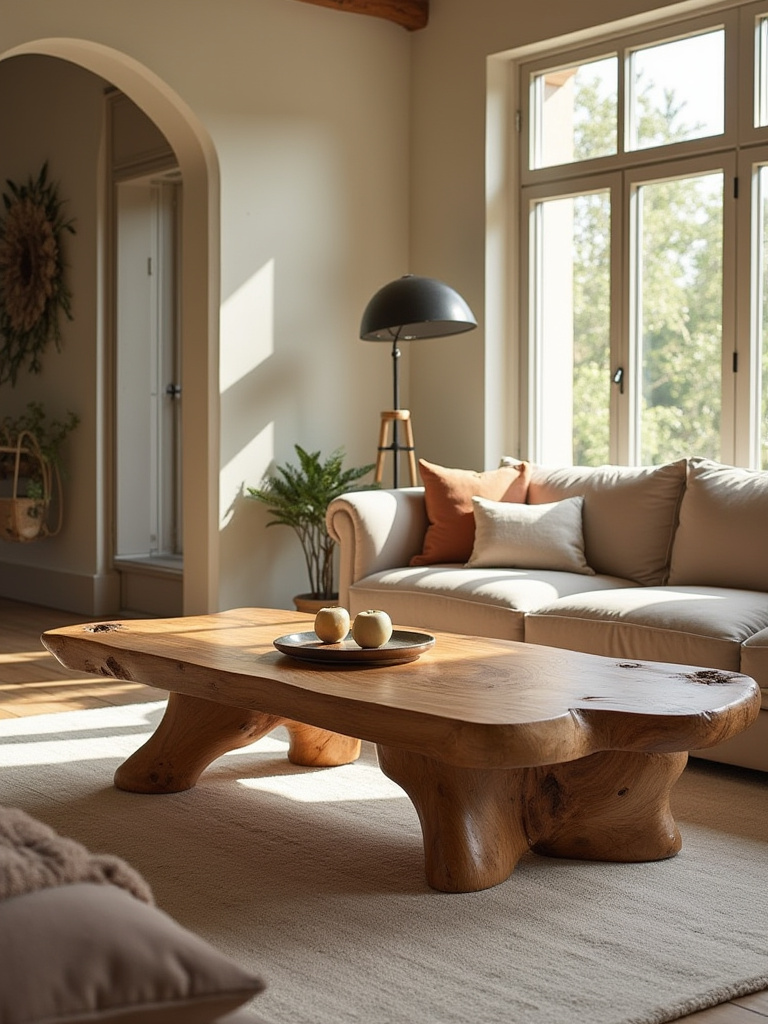
Vintage and antique pieces represent the ultimate in sustainable luxury, offering unique character while preventing waste. High-quality vintage furniture often surpasses modern pieces in construction quality and materials, having already proven its durability through decades of use. Professional restoration can return these pieces to like-new condition while maintaining their unique character and history.
Consider end-of-life planning when purchasing new pieces. Quality furniture should be designed for disassembly and material recovery rather than disposal. Some manufacturers now offer take-back programs or use materials that can be recycled or composted at the end of their useful life. This circular approach to luxury consumption reduces environmental impact while maintaining high standards.
Support local and regional makers when possible. This reduces transportation emissions while often providing opportunities to customize pieces and build relationships with craftspeople. Local makers also understand regional climate conditions and can recommend materials and finishes that perform well in your specific environment.
Sustainable practices complement the final element of luxury living room design: the personal touches that make a space uniquely yours.
18. Add Personal Elements That Tell Your Story
The difference between a luxury showroom and a luxury home lies in the personal elements that reflect your life, interests, and experiences. These finishing touches—artwork, books, collections, and meaningful objects—transform even the most beautiful luxury living room furniture into a space that feels authentically yours rather than generically expensive.
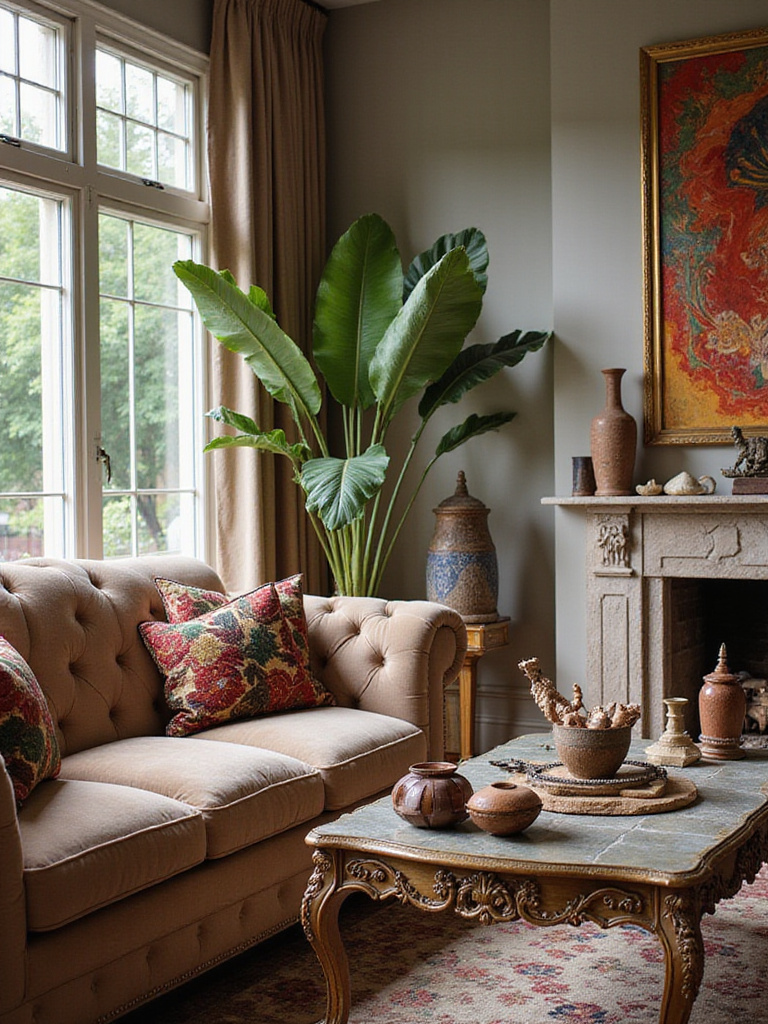
Layer in items with personal significance rather than buying everything at once from a single source. A vintage map from a meaningful trip, books that reflect your interests, or artwork from local artists creates a collected-over-time feeling that money can’t buy instantly. These elements provide conversation starters and make guests feel they’re learning about you through your space.
Balance personal items with the overall aesthetic to avoid clutter or visual chaos. Group smaller items together for impact, use consistent color palettes to unify diverse objects, and leave breathing room around important pieces. The goal is creating vignettes that feel intentional rather than accidental accumulations of stuff.
Consider how personal elements will evolve over time. Leave space for new acquisitions, seasonal changes, and growing collections. A truly successful luxury living room accommodates life’s changes while maintaining its sophisticated foundation through quality furniture and thoughtful design principles.
Conclusion
Creating a luxury living room that truly works for your life isn’t about following rigid rules or spending the most money—it’s about making informed choices that balance beauty, function, and personal meaning. These 18 tips provide the framework for curating a space that feels both aspirational and livable, sophisticated yet family-friendly.
Remember that luxury living room furniture should enhance your daily life rather than constrain it. The best pieces are those that age beautifully, adapt to changing needs, and continue bringing joy years after purchase. By focusing on quality over quantity, function alongside form, and personal meaning within professional design principles, you create a space that truly reflects your values and lifestyle.
Start with one or two key pieces that speak to you, then build gradually using these principles as your guide. Your luxury living room will evolve over time, becoming more personal and more beautiful as you live with and love your carefully chosen pieces. The investment in quality, both in materials and in thoughtful selection, pays dividends in daily comfort and long-term satisfaction.
